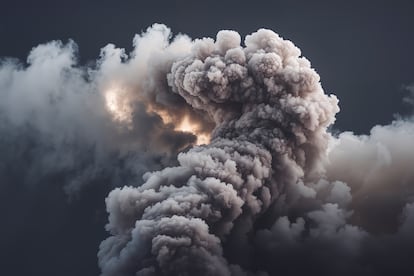Can air take shape and explode into a thousand pieces?

Strictly opinion pieces that reflect the author's own style. These opinion pieces must be based on verified data and be respectful of individuals, even if their actions are criticized. All opinion columns by individuals outside the EL PAÍS editorial team will include, after the last line, a byline—no matter how well-known—indicating the author's position, title, political affiliation (if applicable), or main occupation, or any that is or was related to the topic addressed.

The coup d'état that preceded the Civil War—July 1936—surprised Ramón J. Sender in the Guadarrama mountains; a bucolic setting that would soon be disrupted by the war that the Huesca writer experienced on the front lines, and whose testimony would be revealed in Contraataque (Deusto), a book that has just been reissued these days.
This is a first-person chronicle, sharp, harrowing, and riddled with the fratricidal fire of fraternal blood. Within its pages, we find shrapnel, death, and explosions; bodies and trucks exploding that make Ramón J. Sender feel "the corporeality of the air," the sensation that the air "is a body" that shatters every time a grenade is thrown. Explosions that split open bodies, revealing "arteries and skulls," to use the writer's own words . Faced with such a graphic description, it's possible to simply explain the perception of air shattering into a thousand pieces; the same perception Sender had when faced with the explosions that scorch reality and transcend the written page.
First, we must understand that air is a mixture of gases, molecules with their specific, though barely perceptible, mass, which have weight, as we can see if we fill a balloon with air and place it on a scale next to an empty balloon. To explain the visual effect in a simple way, suffice it to say that this mass of air is going to be compromised by trinitrotoluene, or TNT, the organic compound used to load the hand grenades Sender talks about in his book. Trinitrotoluene is a compound that appears in the form of flakes and, when detonated, disrupts air pressure, increasing it and its temperature, and propagating this mass at great speed, its shock wave displacing everything in its path.
This is when the air becomes visible, that is, it is perceived for what it is: matter consisting of weight and occupying space, since, in contact with trinitrotoluene, it releases explosive energy; a visual phenomenon perceived as if the air itself were exploding. The grenade breaks its shell and its fragments reach the bodies, but this is barely noticeable , as Ramón J. Sender recounts when he writes that "the grenade was invisible; it seemed as if the air itself, swirling and compressed under mysterious pressures, suddenly exploded, breaking arteries and skulls around it."
Although Sender didn't see the grenades, he witnessed their destructive power . In doing so, he recorded a journalistic account of his experiences during the early stages of the Civil War, when the conflict began to spread throughout the country in an atmosphere that took shape with each explosion, shattering into a thousand pieces across a landscape that ceased to be bucolic and became a veritable hell.
Do you want to add another user to your subscription?
If you continue reading on this device, it will not be possible to read it on the other device.
ArrowIf you want to share your account, upgrade to Premium, so you can add another user. Each user will log in with their own email address, allowing you to personalize your experience with EL PAÍS.
Do you have a business subscription? Click here to purchase more accounts.
If you don't know who's using your account, we recommend changing your password here.
If you decide to continue sharing your account, this message will be displayed indefinitely on your device and the device of the other person using your account, affecting your reading experience. You can view the terms and conditions of the digital subscription here.

Journalist and writer. His notable novels include "Champagne Thirst," "Black Powder," and "Mermaid Flesh."
EL PAÍS







